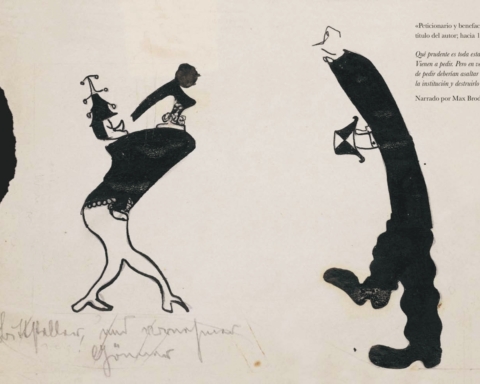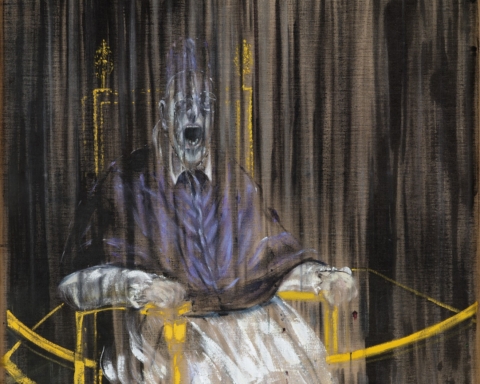1.The Democratic Path to Fascism
The assertion that all power is a “power of exception” has become commonplace. However, that affirmation does not explain the different between a fascist regime and a constitutional regime. “There is no difference,” retorts the person who believes in the normality of the “exception.” Try saying that to the people of Brazil, who face Bolsonaro’s imminent assumption to power, and you will hear the response: “you are crazy!”
In the revolutionary Marxist tradition, the analogy between the democratic regime and the fascist regime is rejected. The Third International imposed that similarity (that quickly turned into an identity), and we all know how that ended. The concept of constituent power must be considered with equal attention and discernment: it cannot be confused or mixed with the “political exception” and its exercise – as claimed by the proponents of the “autonomy of the political” (who, in the trail of Carl Schmitt, only see a figure of “exception” in constituent power).
In regards to what happened in Brazil, it must first be noted that fascism did not arrive through a classic “coup d’etat” (from outside of the democratic institutions), through the exception (as what more or less happened with Latin American fascisms, up until Pinochet and the Argentine military junta), but rather from within the constitutional process. It did not arrive through a rupture with constitutional legality, but through the constitutional construction of a new legitimacy. Second, I tend to believe that the fascist Brazilian government will not exercise power through an external and violent transformation of the constitutional regime, but through a slight reduction (except for the Black population) of civil liberties and through the existing Constitution’s governance. That is, through putting a sort of “constituent power” in motion within governance – a power that is functional, absorbed within governance and at the same time able to determine profound modifications in its constitutional fabric. This perverse path of democracy, that is now installed in Brazil but that has been experienced, in part or in full, in other situations and countries (such as Turkey and Egypt, not to mention the former socialist countries) should be submitted to criticism. We must not only ask what does “representative democracy” mean today, but also what does “democracy” in general mean. Then based on that, ask how, through what forms and with what objectives, should we mobilize in order to build and defend a Constitution that respects freedom, that constructs equality and creates its conditions. And finally ask ourselves if it is still possible to raise these questions or if we have to reconsider the very fabric that sustains them?
2. An Institutional coup d’état
A constitutional coup d’état and/or a democratic coup d’état: that is how we can name what happened in Brazil and incorporate it into a new academic typology of constitutional law. The overthrow of the legitimately existing power and its substitution for a power that is not legitimated by universal suffrage, but by an organ of the State, Congress, was carried out behind a constitutional mask. It started with the impeachment of the President and continued with her replacement – merely by parliamentary means, without a new general election –, shortly after the the electoral renewal of her presidential mandate. The coup later continued (which is not irrelevant) with Congress’s immediate approval of several laws characteristic of a neoliberal regime (among which we should highlight the law that prohibits increasing social spending for a long time) that, in a expeditious and treacherous way, revoked the material paradigms of the standing Constitution.
The connection between Dilma’s impeachment for political-moral reasons (corruption) and the liquidation of the political orientation of her government through the constitutional affirmation of a neoliberal principle, reveals that there was a partisan nature to her dismissal, which classifies it as a coup – a radical modification of the political direction of the government, or in other words, of the material constitution. This opened the way for making sure that, even in the case of new elections, a diverse presidential majority (that the polls attributed to Lula) could not reestablish what was now constitutionally vetoed: non-liberal proposals for redistributing income, or rather, alternatives to the newly decided economic legitimacy. In support of continuing liberal politics, and therefore renovating state policies outside of (and before) their popular legitimization, the judicial power mobilized through the condemnation and imprisonment of Lula and, later, through his electoral exclusion. It is not a coincidence that this judicial power has been immediately co-opted by Bolsonaro’s government. Finally, the elections were held under the threat – which once again is not external to the institutional process – of intervention by the national army, in the case of the left’s victory. At this point, the new President was elected, a 21st century fascist, restoring, in this way, the democratic legitimization of power. A very doubtful, yet effective, restoration. In the government that takes power at the beginning of the year, along with the Lava Jato judge (the operation that, as judge Greco has expressly declared, has nothing to do with Mani Pulite), there will be a Chicago Boy in charge of Finance and the Economy, in the Chancellery, a man linked to the alt-right and Trump’s policies, while the army will be given the functions of a Ministry of Order.
This perverse path-line that goes from democracy to fascism is organized not by external movements but by the very institutions of constitutional power through the adaptation of the organs of control to the political lines of the extreme right (especially the magistrate). The revelation of a coherent design running through the institutions, destroying all connections and influencing new conformations of the formal figures of the Constitution and the materiality of its political direction, which is guaranteed in the process of electoral legitimization, thus suppresses any ethical character of the democratic principle. All of this calls for – when the indignation subsides, if that happens – a reflection on the very issue of democracy.
But it is not enough. The fascist-populism of Trump-Bolsonaro further violates democracy. Direct democracy is taken up, in a mass and mystified way by those fascist leaders, and transformed from a mode of government into a figure for the legitimization of a government. Trump’s tweets interpret that conversion. Social media and the institutional press voluntarily take on that legitimizing function. Moreover, it can be said (and there is vast literature on the topic), that they produce it, or at least they make it possible. When the indignation subsides, we will still have to raise the question of freedom of expression in relation to power. This is the first problem that a resistance movement must confront, saying “Books yes, weapons no” (as they are starting to say in Brazil), but it will have to start by liberating free expression. Indeed, the contradiction between freedom of expression (constitutionally protected) and money (= property = corruption = the criminal use of falsehood by the mainstream media…) seems unsolvable. But it is only so for those who continue seeing it as a Gordian knot and do not trust that a sword can cut through it. A political force that wants to get out of the mud in which democracy and fascism are encased, must pose that problem as the first to be solved.
3. A General Problem
There is a process underway in the United States that is analogous to that of Brazil. The strength of that country’s democracy and the value of its Constitution have prevented, so far, the transformation from assuming the perverse and even grotesque element of what is happening in Brazil. In the United States, the presence of opposition forces can still block (or make uncertain) the crystallization of a tendency like the Brazilian one. However, this does not erase the fact that a reactionary consolidation of power is taking place. It is seen in the Republican Party’s strong shift toward the Trumpian core (behind which lies the supremacy of the alt-right), the twenty years of the Supreme Court’s orientation in ultra-conservative positions, the realization of colossal financial operations for media control of voting, etc.
In a much more fragile way, but with sometimes ferocious acceleration, similar processes are occurring in Italy. However, the populist political horizon is expanding in Europe and in Latin America. This expansion dramatically deepens the problem we are raising here: how is fascism established in and through democratic institutions? And second, what exactly is this fascistizing insurgency?
Next we will try, if not to answer, to introduce this question in more detail. For now, let’s start by defining this strange fascism, which is presented in profound combination with neoliberalism. Better yet, let’s try to define the difficulties that – we believe – a new radical experiment of the Chicago theories must encounter in its development. The current fascistizing transformations of the capitalist managing class (not all of it, for the moment), in fact, seem to be determined by the need to sustain with greater force, using all the means of the state, constrictively, a more neoliberal development of the deep crisis. It is important to highlight this unusual deformity: the force of authoritarianism is called up to sustain the crisis of liberalism. Now, according to this perspective, fascism seems to appear (although not only) as the hard phase of neoliberalism, as a strong recuperation of sovereignty, as the inversion of the slogan “first the market, then the state,” in several figures, in the points where development clashes with most difficulties, or where its apparatuses break, or better, where it confronts strong resistance.
This fascism is characterized by a reactionary reflection. This is what distinguishes it from the fascisms of the 1920s and ‘30s, when the reactionaries acted on the political plane, while they could be relatively progressive on the economic terrain, pseudo Keynesians. This reaction then is probably a symptom of weakness, an effect of response more than an attack. Which seems to be proved by the fact that this fascist instance, more than a totalitarian technique, attempts to use flexible mechanisms for the authoritarian transformation of the state, calibrating governance like a sort of new and perverse constituent power. But these are only predictions, that only the intensity of future class struggle can confirm or deny.
We still have not asked: what is 21st century fascism? That of the 20th century sought to destroy the Soviets, in Russia or in any other part of the world where they could be found. Where are the Bolsheviks today? They are obviously fantasies. But neoliberalism’s fatigue in consolidating itself and the political crises that are added to the economic ones revive the fear of Bolsheviks. That insistence is astounding.
To attempt to rationalize it, let us venture a hypothesis that would allow us to classify these fascist tendencies in an era in which the development of the mode of production has placed the multitude in the center of class struggle. Now, the multitude is a set of singularities, linked by social cooperation. For the multitude (especially in the metropolises), the element of cooperation is the main point of its existence as a class. In productive terms, that cooperative power leads the multitude toward the common. However, when strong tensions intervene that act on the singularities (that compose the multitude) in terms, for example, of economic or environmental insecurity and fear of the future, then the multitudinous cooperation can implode as a defense of identity. The fascism of the 21st century seems to be sustained by such incidents in the cooperative nature of the multitude.
4. Fascism and Neoliberalism
If in the era of Plato, democratic constitutions were inadequate for stopping the crisis of democracy, in the current situation they favor the rise of fascism, generating corruption. Modern democratic constitutions were organized due to the dynamic confrontation of interests, eventually in coalitions by the right and the left, in relation to a model of enmity and of the peaceful and regulated solution to that enmity, following the hypothesis of a balanced opposition between contrasting interests. Today, globalization has led to the homogenization of governance at the global level (it could be said: toward homologation), since governing in globalization requires composing the relationship between the formal and the material constitution through the insertion of rules that emerge from the multinational monetary relations of companies in the global market – and that therefore, substantially eliminate confrontation/conflict internal to the constitution itself. The extremism of the center, the large coalitions, have been, in this sense, fundamental moments of the recomposition, through governance, of constitutional profiles with a global reach. But this phase ended, and the upsurge in conflicts has led to a profound crisis of the traditional forms of liberal-democratic governance. What occurs then are the experiments in rupture: America first, Brexit, and now Brazil first, Italy first…
Governance (that is, the set of apparatuses that unitarily shaped the horizon of national governments and global government) is subject to increasingly frequent constitutional incidents, that have primarily had the effect of obliterating the aspects of progressive democracy that constitutions inherited from the second post-war period and the end of the Cold War. In this way, the physiognomy of states is transformed at the expense of democracy. The long 2007 crisis made things worse. Governing the crisis always implied that it was the crisis that imposed its demands on democracy. Today we can fully weigh the consequences of those events. Increasingly, the dialectical constitutional dynamics are not taken into account, oppositions are integrated into governance, Keynesianism is destroyed with the consent of the Keynesians. The eventual operations of exception occur directly within democratic governance, as if they were responding to hidden articulations of a constituent power, more than to controllable mechanisms or options. What I want to say is that the transformation that these movements suggest is today commanded by destructive power of democracy.
With the crisis and weakening of North American power – that had determined a certain global equilibrium, at least in its area of domination – these processes accelerated, spreading chaos everywhere. The new fascism is established within this chaos. Assembling itself from the neoliberal project to dominate it, will it find the conditions for its sustained development? It will be difficult. In these conditions, neoliberalism finds itself in a desperate situation, if it is to reestablish equilibrium. Having dislocated or rejected the old democratic constitutional equilibrium, now it is exposed to the void. It needs something new to respond to the new difficulties, and it only finds it under the form of authoritarianism, of renewed fascism… To survive this leap into the void, it has to resort to media or ideological instruments, it has to defame and destroy the forces that have confronted it (sometimes timidly, or even anticipating its destructive directions – this crisis is prolonged and deep, and the responsibilities are still to be defined). Those forces were social democratic, Keynesian ones. But the neoliberals that make up the new formula of fascistic government in Brazil call them communists and Bolivarians, propagators of chaos. In the United States, they are the stupid city dwellers that subvert the national identity. Thus, this fascism founded on the ideological void is classified as a falsifier of memory and reactionary restorer of past identities. If it is a slave-holding past, as in the United States, it is worrying; if it a present with slavery, like in Brazil, it is even more troubling.
5. We must not be afraid
My Brazilian friends wonder how Bolsonaro’s victory was possible, why their fellow citizens voted for him in such large numbers. The answer is simple: they did not vote for fascism, but for the end of corruption and security, at a critical juncture of their lives for which, in reality, a part of the population blamed the PT. It is not difficult to think that the racist motivation and the defense of the family (see the absurd polemic about the issue of gender) formed the fascist coagulation of that malaise. It is an easy prophecy to make, as we have already indicated, that Bolsonaro will not manage to institute his government as a regime. To the previously mentioned obstacle in relation to the conjugation of fascism and liberalism, there are additional specific internal difficulties: faced with the tactical impediments created by the dispersion of votes in Congress, they will be forced to continue buying the parliamentary majority from Evangelicals or other mercenaries; there will be an even higher price to pay the ruralists for their electoral support, for sustaining the government, and in the negotiation of the ecological limits to the expansion of their interests; the extreme proposals for privatizing public patrimony will be met with hostility by the army in the name of the nation, etc. It will not be easy for them to advance. And even the consolidation of this victory will be difficult, very difficult: it will clash contradictorily with the same fixed values of the Brazilian economy (open to international food and energy markets, closed on enormously important ecological limits, pushed by a strong productive dynamic due to the breadth of the labor market). We are – it seems – in a margin in which the promises of Bolsonaro’s victory collide with the intentions of his neoliberal partisans. How can they be balanced? We are not in the 1930s, when fascism was organized around a form of planning that favored large industry (of war) and large banking capital – but with a surplus, that represented immediate social benefits for the proletariat.
What makes us tremble, after Bolsonaro’s victory, is anticipating the disasters that this government is going to produce anyway, given that it is incapable of developing a political project that is not a razzia against the poor, against Blacks, and, generally, an anti-social program (as shown by its ultra-liberal proposal). Militaristic, homophobic, sexist, guided by hatred toward a majority Black population (we are far from the 54% whites in the 2000 census), Bolsonaro will be faced with a non-white demographic push, which does not stop growing. The coming disaster is enormous and its consequences will be felt for a long time.
What must be done, then? We must stop crying, we must get down to work, taking comfort in the awareness that the fascist cadre is still weak. In what sense, with what spirit, should we start working? The provocations are already numerous, and in the future they will multiply. In the universities there are squads and right-wing groups putting together lists of communists, school programs start to be filled with invocations to a slave-holding past, etc. We must not be afraid. Not having fear becomes the key element for building a resistance.
Fascism is based in fear. Here it awakens and cultivates fear of Blacks and of communists. But this duo is a symbol of life, and its struggle is a sign of liberation. The leftist parties, starting with the unrecoverable PT, are in crisis. It is in the relationship and political recomposition of Blacks and communists that a radically antifascist left can be built. This step is fundamental. There cannot be antifascism in Brazil without a political composition between the white communists and the Black population. It goes without saying that the spark of this recomposition, today, are the feminist movements. They are majoritarian movements, and the majority is not afraid.
* Translated by Liz Mason-Deese






